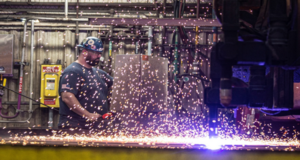
The Coast Guard last Friday said that Bollinger Shipyards last month began cutting steel on the first of eight prototype modules for the service’s future polar security cutter (PSC), providing the shipbuilder with lessons on the processes and techniques it will use to produce the ship, which is slated to enter production in 2024. A heavy polar icebreaker has not been built by a U.S. shipyard in nearly 50 years, which is one reason the first PSC is three to…

 By
By 











